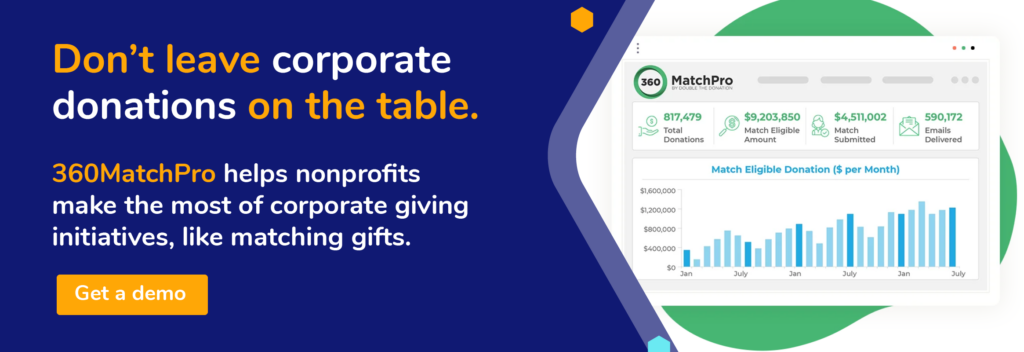What is Corporate Philanthropy? What Nonprofits Need to Know
Nonprofits receive donations and support from a variety of sources, but corporate partnerships stand out as one of the most essential and reliable funding streams. Considering the major benefits that corporate partnerships can offer, your nonprofit needs a defined strategy to raise more from corporate philanthropy and build stronger relationships with businesses.
In this guide, we’ll review the basics of corporate philanthropy so that your nonprofit can start earning more through this lucrative funding source. Here’s what we’ll cover:
- What is corporate philanthropy?
- Benefits of corporate philanthropy
- Types of corporate philanthropy
- Corporate philanthropy trends
- 7 effective corporate philanthropy examples
- 7 tips to raise more through corporate philanthropy
Once you understand corporate philanthropy inside and out, you can develop processes to grow this funding stream and better engage with corporate donors. Let’s begin!
What is corporate philanthropy?
Corporate philanthropy refers to the programs and initiatives that businesses undertake to support nonprofits and charitable causes. This often involves direct donations but can also include in-kind gifts, volunteer time, pro bono services, and other forms of support. Let’s look at the perks available for both sides.
Benefits of corporate philanthropy
Corporate philanthropy offers win-win benefits for both corporations and the nonprofits they support.
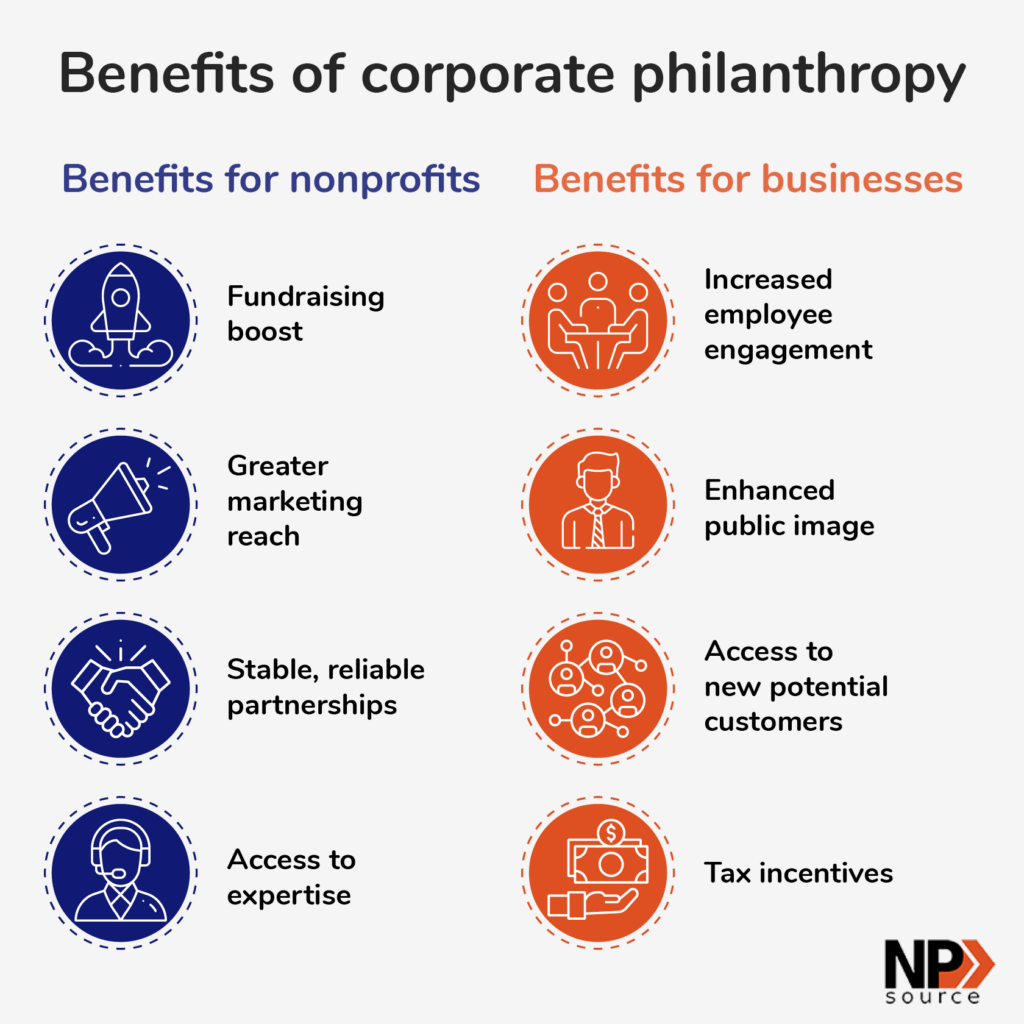 Benefits for nonprofits
Benefits for nonprofits
Nonprofits can access the following advantages by developing strong corporate relationships:
- Fundraising boost. Corporate sponsors can offer much-needed donation influxes, whether cash or in-kind gifts. They can also provide the necessary funding to put on certain initiatives, like events or major campaigns.
- Greater marketing reach. When corporate partners share information about your nonprofit with their customers and employees, they can introduce your mission to a wider audience of potential new supporters.
- Stable, reliable partnerships. Along with occasional major boosts, corporate partnerships can also provide access to ongoing, sustainable funding.
- Access to expertise. Corporate partners can offer expertise in the form of pro bono work or volunteer time, allowing nonprofits to access insights straight from experienced professionals.
Benefits for businesses
As a nonprofit professional, it’s important to understand what motivates businesses to get involved with corporate philanthropy so that you can tailor your outreach to their interests. Here are a few benefits for the for-profit sector:
- Increased employee engagement. According to America’s Charities, 70% of employees say it is imperative or very important to work for an employer where mission and values align. Today’s employees expect the companies they work for to support charitable causes and offer opportunities to get involved in nonprofit work.
- Enhanced public image. Consumers are also seeking out businesses that promote social good. 72% of consumers say they would recommend a brand that supports a good cause over one that doesn’t.
- Access to new potential customers. Through nonprofit partnerships, businesses can market their products or services to the nonprofit’s supporters.
- Tax incentives. Businesses can receive charitable deductions for donations made to nonprofits.
Corporate philanthropy trends
What does the current state of corporate philanthropy look like? Understanding how businesses and nonprofits are currently approaching corporate philanthropy can help you develop smart strategies based on facts.
Here are a few statistics that paint a picture of current corporate philanthropy trends to be aware of:
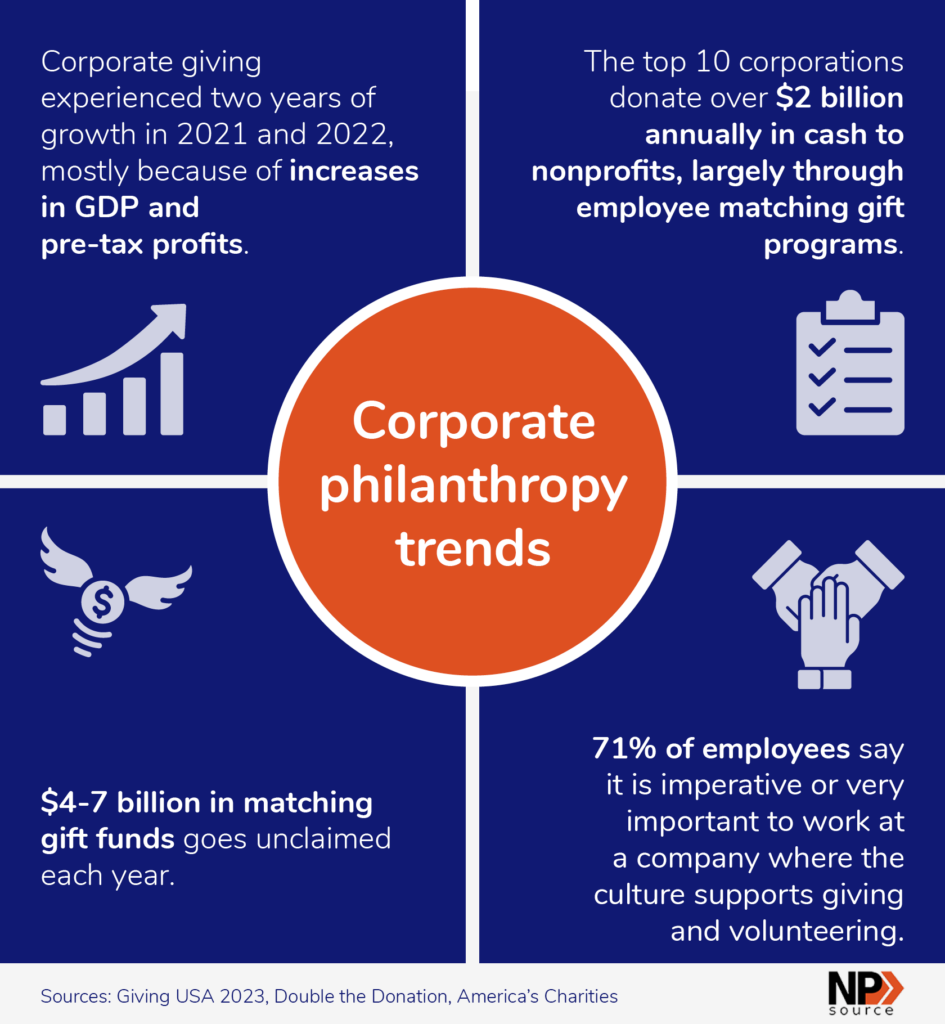
- Although total giving declined in 2022, corporate giving experienced two years of growth in 2021 and 2022, mostly because of increases in GDP and pre-tax profits.
- The top 10 corporations donate over $2 billion annually in cash to nonprofits, largely through employee matching gift programs.
- $4-7 billion in matching gift funds goes unclaimed each year, mainly because many employees aren’t aware that their employers will match their charitable contributions.
- 71% of employees say it is imperative or very important to work at a company where the culture supports giving and volunteering.
For a more comprehensive look at how companies support nonprofits, check out our corporate giving trends article. In addition to the statistics above, the research we share demonstrates the increasing impact of corporate philanthropy and the desire for employees to have opportunities to engage in workplace giving.
Essentially, businesses and their employees want to support nonprofits like yours. The question is, what is your organization doing to foster these powerful relationships? Later on, we’ll cover a few strategies to help raise more from corporate giving. But first, we’ll break down the most common ways that companies could support your organization.
Types of corporate philanthropy
Corporate philanthropy can take many forms, supporting every aspect of your nonprofit’s work. These are a few common corporate philanthropy initiatives that companies may offer:
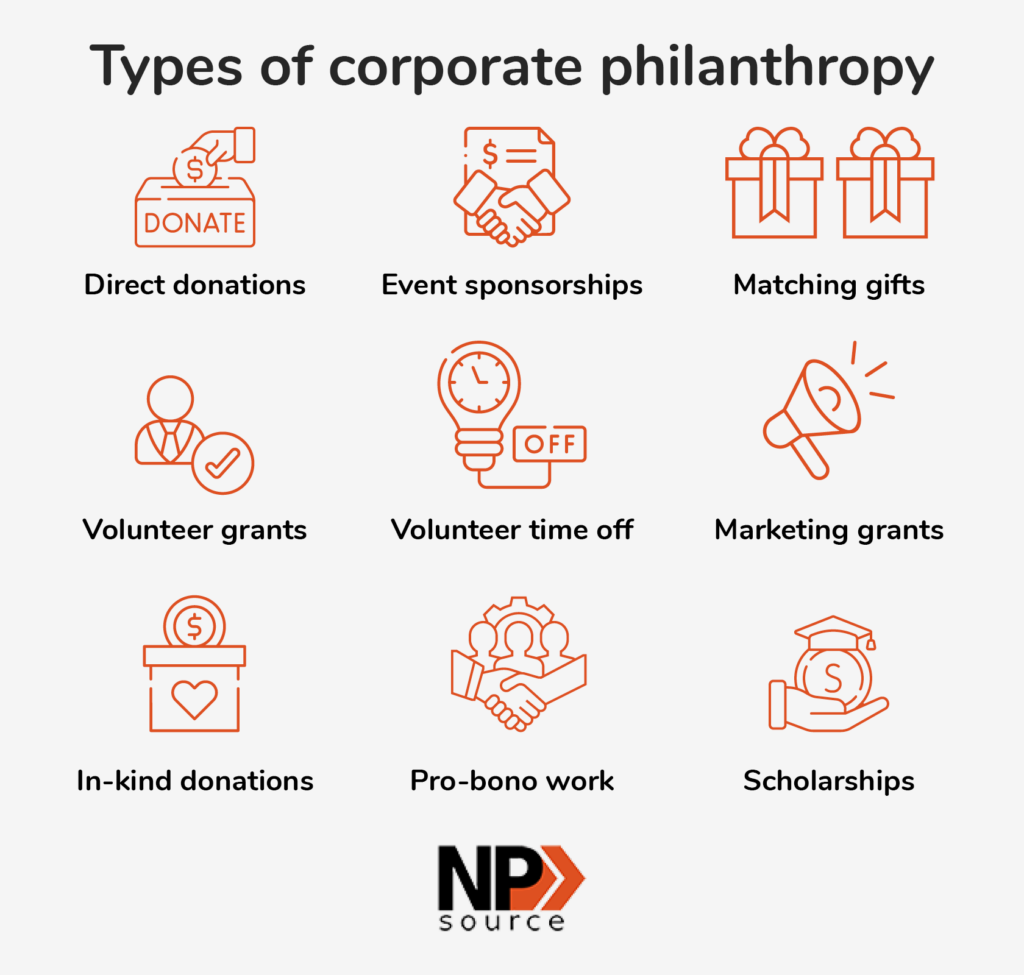 Direct donations
Direct donations
This involves monetary gifts made directly to your nonprofit’s campaigns, such as your annual fund or GivingTuesday campaign.
Event sponsorships
Nonprofit fundraising events often require funding to secure venues, hire security personnel, rent tables, chairs, tents, and other equipment, and purchase refreshments. Businesses can sponsor your organization’s events to help cover these costs and ensure more of your event revenue goes directly toward your projects and programs.
Matching gifts
In matching gift programs, businesses match donations that their employees make to eligible nonprofits. Most businesses match at a 1:1 ratio, but some will match at a 2:1, 3:1, or even 4:1 proportion.
Volunteer grants
Volunteer grants (also known as Dollars for Doers) are donations that companies submit to nonprofits after their employees have volunteered with those organizations for a specific amount of time. For example, a company may offer a $100 donation for every 10 hours an employee volunteers with an organization.
Volunteer time off
Volunteer time off (VTO) is paid time off that businesses offer to employees to use for volunteering with a nonprofit or charitable cause.
Marketing grants
Marketing grants are funds that corporations offer to support nonprofit marketing efforts on specific platforms. For example, Google offers the Google Ad Grants program, giving nonprofits $10,000 per month to spend on Google advertising campaigns. Microsoft offers a similar ad grant program for their websites such as Bing and Yahoo.
In-kind donations
In-kind donations are a form of noncash donations and are typically goods or services. Rather than giving a monetary gift, companies will directly donate supplies or equipment to support a nonprofit’s cause.
Pro bono work
Businesses can offer their expertise to nonprofits for free to help support the organizations’ missions. For example, corporate employees may offer services like:
- Legal consulting
- Financial management
- Marketing and graphic design consulting
- Event planning
- Website development
By taking advantage of these opportunities, nonprofits benefit from expert support without having to spend their (often limited) budgets to access necessary resources.
Scholarships
Businesses often fund scholarships for university students to help cover costs like living expenses and educational materials. Students typically have to seek out and apply for this funding themselves.
7 effective corporate philanthropy examples
What do these corporate philanthropy initiatives look like in action? Let’s review a few examples of effective corporate philanthropy programs and how they’ve supported nonprofits and charitable causes.
1. Patagonia
Patagonia takes a very active role in promoting social good through corporate philanthropy. The sports and athletic gear company offers a Worn Wear program for customers to turn in used clothing or get their items repaired, promoting a sustainable mindset.
Patagonia also has a robust corporate social responsibility program that promotes equitable labor practices and sustainability throughout every production phase. In addition, they direct funding toward organizations that seek to protect the environment and support historically marginalized groups.
2. Bombas
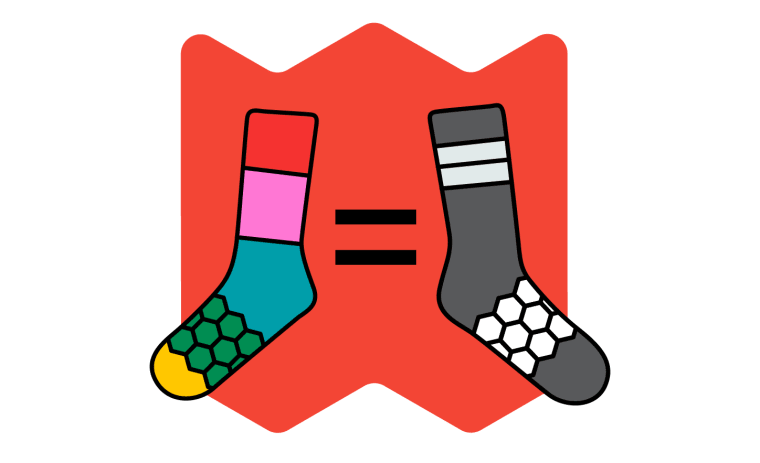
Bombas is a clothing brand best known for well-made socks. Bombas has an impactful in-kind donations program where one item of clothing purchased equates to one item donated to those in need. Donations are made to overnight shelters, transitional housing, rehabilitation centers, schools, and other organizations in need.
This type of corporate philanthropy initiative is so influential because customers can make a direct impact on organizations in need, just through their regular purchases.
3. Google
Google.org is Google’s philanthropic arm that details the company’s charitable projects, from pro bono work to cybersecurity efforts to fighting climate change. As mentioned, one of Google’s longest-lasting programs to support nonprofit organizations is the Google Ad Grants program. This grant helps nonprofits achieve better visibility for their online content and connect with a wider audience of potential supporters.
Interested in learning whether your nonprofit is eligible for a Google Ad Grant? Watch Getting Attention’s explainer video to learn more:
As of 2022, Google has donated over $1.8 billion in Search ad funding to nonprofits around the globe.
4. Microsoft
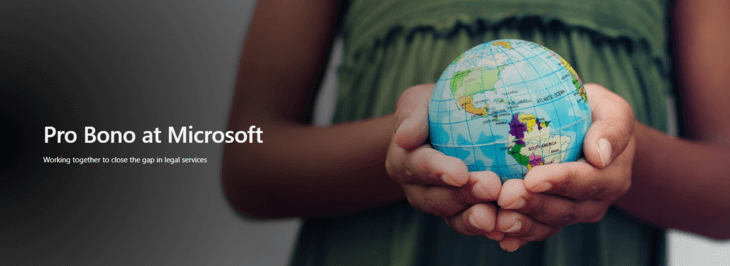
In addition to its marketing grant opportunities, Microsoft pursues a variety of corporate social responsibility initiatives. These include commitments in the following areas:
- Inclusive economic development
- Human rights
- Sustainability
- Earning trust in the tech space
Microsoft also offers pro bono legal services to those in need, such as low-income Americans or immigrants. The company partners with many nonprofits, legal services organizations, law schools, and law firms to collectively work toward greater equity in the legal realm.
5. Nike
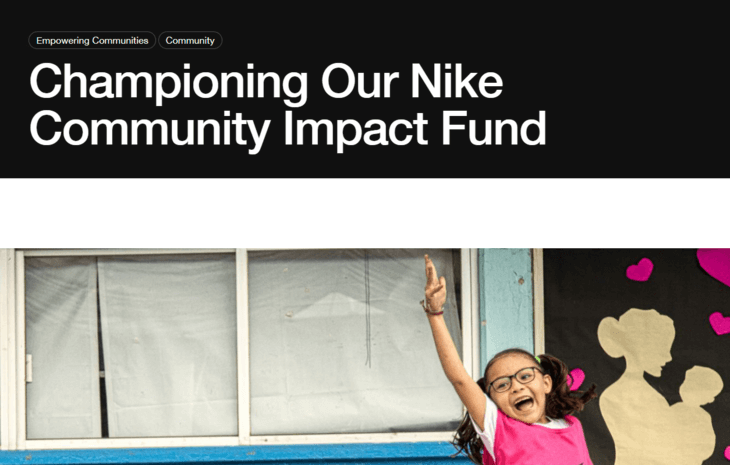 Nike’s corporate philanthropy projects include a matching gift program and volunteer grant initiative where the company donates $10 per hour volunteered, up to $2,500 per year. Nike employees volunteer with sports teams in local schools and community organizations through Nike’s Community Ambassador program.
Nike’s corporate philanthropy projects include a matching gift program and volunteer grant initiative where the company donates $10 per hour volunteered, up to $2,500 per year. Nike employees volunteer with sports teams in local schools and community organizations through Nike’s Community Ambassador program.
The company also offers an employee-led grantmaking program called the Community Impact Fund. In this program, local charitable organizations apply for grants, A volunteer committee made of Nike employees reviews the grant applications and uses their local insights to determine where funding will make the greatest difference.
6. Coca-Cola
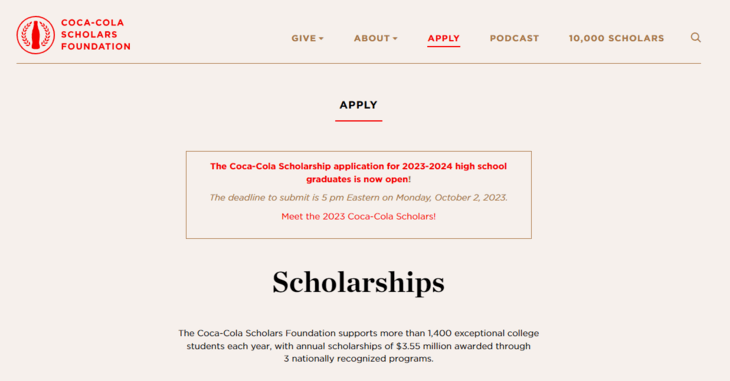 Coca-Cola is devoted to philanthropy through the Coca-Cola Foundation, a corporate philanthropy program that prioritizes grantmaking to fund sustainability projects, climate resilience, economic development, and more.
Coca-Cola is devoted to philanthropy through the Coca-Cola Foundation, a corporate philanthropy program that prioritizes grantmaking to fund sustainability projects, climate resilience, economic development, and more.
The beverage company also offers a Coca-Cola Scholars Program Scholarship for high school students heading to college. The merit-based $20,000 scholarship is offered to 150 scholars each year who are selected for their leadership skills and commitment to making a positive difference in their community.
7. Salesforce
Salesforce, one of the largest technology companies in the world, pursues corporate philanthropy projects in areas like education, workforce development, and climate and community resilience.
Salesforce promotes an integrated philanthropy approach called the 1-1-1 model. This involves contributing 1% of the company’s equity, 1% of its product, and 1% of employees’ time back to the community.
7 tips to raise more through corporate philanthropy
As you can see, there are plenty of opportunities for your nonprofit to engage in corporate partnerships that bring mutual benefits to both organizations. By strategically making the most of these opportunities, you can bring long-lasting benefits to your organization.
Use these strategies to start earning more through corporate relationships:
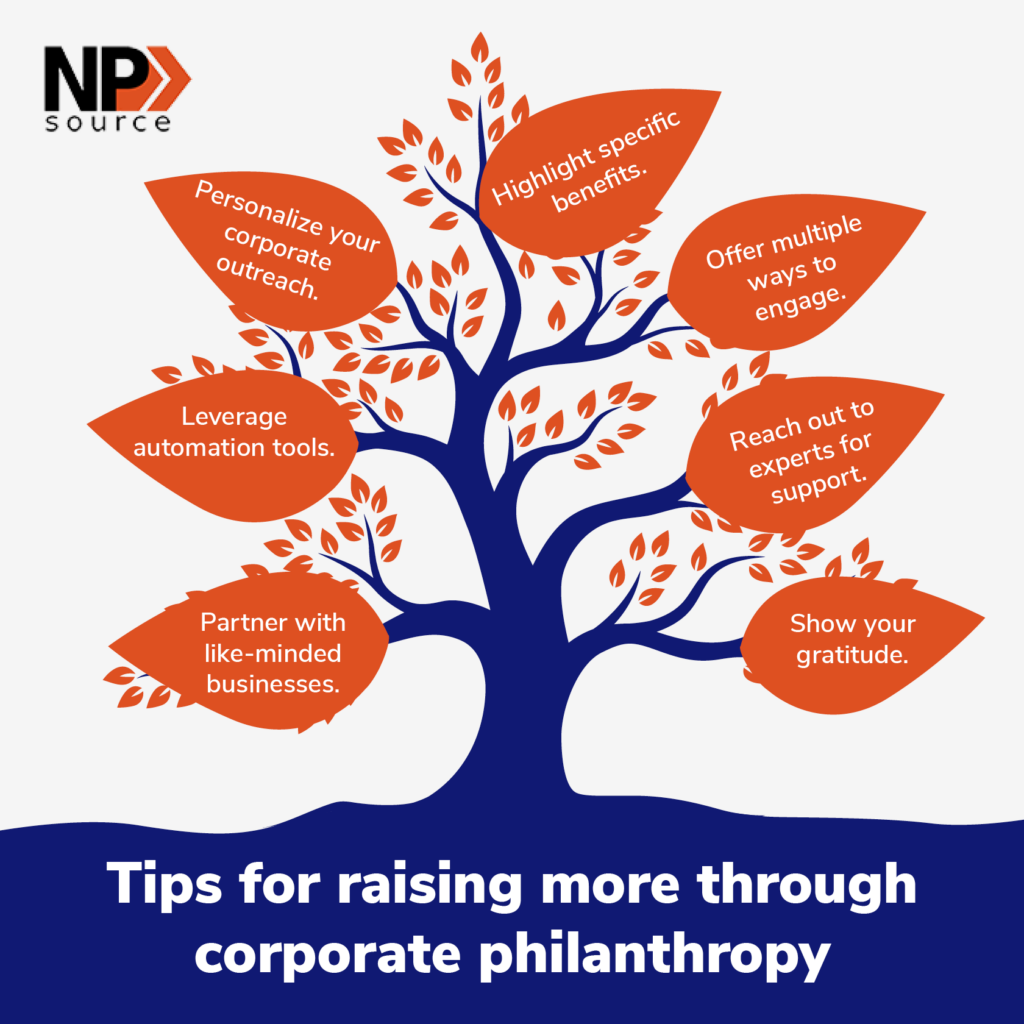
- Partner with like-minded businesses. Seek out corporate partners that have similar values and missions to your organization. These businesses will also likely have a similar audience to your nonprofit, making your marketing efforts more effective for both organizations. For example, it would make sense for an animal shelter to partner with a pet store because pet owners would likely also be interested in supporting animal welfare organizations. The pet store can also offer relevant in-kind donations such as bowls, leashes, cat toys, and dog beds.
- Leverage automation tools. Automating your corporate philanthropy efforts helps your team save time and reduce manual data entry errors. For example, consider investing in a CLMA (Certified Leader in Matching Automation) designated matching gift tool that offers auto-submission. This allows donors to automatically submit matching gift requests right from your donation page instead of having to go through their company’s matching gift process on a different website. Note that their employers will need to leverage corporate giving platforms that integrate with your auto-submission tools to enable this function, though.
- Personalize your corporate outreach. Tailor your outreach efforts, such as event sponsorship requests or in-kind donation inquiries, to the company that you’re communicating with. This will make your requests stand out and build goodwill with potential corporate partners. For example, let’s say you’re an environmental nonprofit reaching out to a sporting goods store to sponsor your upcoming 5K. You might say something like, “We think your commitment to promoting outdoor activities in the community aligns perfectly with our mission to keep local parks and waterways clean.”
- Highlight specific benefits. Show potential corporate sponsors the benefits they’ll receive from partnering with your nonprofit. For example, you might demonstrate the marketing benefits sponsors can receive by highlighting the reach of your fundraising events or your social media engagement metrics. Also, show potential partners the positive impact they can make with their gifts, whether through the number of beneficiaries they can help or specific positive outcomes they can help achieve.
- Offer multiple ways to engage. Provide multiple ways for corporate partners to get involved based on their interests or giving capacity. Spotlight opportunities such as corporate volunteering, co-hosting events, or participating in peer-to-peer fundraisers.
- Reach out to experts for support. Consultants can help enhance your nonprofit’s approach to corporate philanthropy by auditing your current strategies and making data-driven recommendations for future growth. For example, you can work with a Google Grants consultant to ensure you’re making the most of your $10,000 in free monthly advertising.
- Show your gratitude. Express appreciation for your corporate partners to foster a positive, long-lasting relationship. Take a cue from your donor appreciation efforts and craft personalized thank-you letters that highlight sponsors’ unique impacts on your cause.
Treat your corporate sponsors just like you treat your major donors — develop personalized stewardship strategies that resonate with their interests and motivations. This can help you develop relationships that last through the years.
Wrapping up
Corporate philanthropy continues to gain popularity — 39% of companies indicated plans to expand their workplace giving programs in the next two years. By following the tips and strategies above, your nonprofit can make the most of these giving opportunities to ensure reliable support for your mission.
Looking for more fundraising best practices? Start with these additional resources:
- Digital Fundraising for Nonprofits: 6 Key Strategies. Want to improve your digital fundraising alongside your corporate sponsorships? Explore this guide for expert tips.
- Google Grant Application: A Nonprofit’s Guide to Applying. Ready to apply for the Google Ad Grant? Review this guide to understand what’s required of your nonprofit.
- Corporate Philanthropy: The Guide for Nonprofits Looking to Build Corporate Relationships & Dollars. Explore more corporate philanthropy tips to ensure your nonprofit is doing everything it can to optimize this giving channel.




